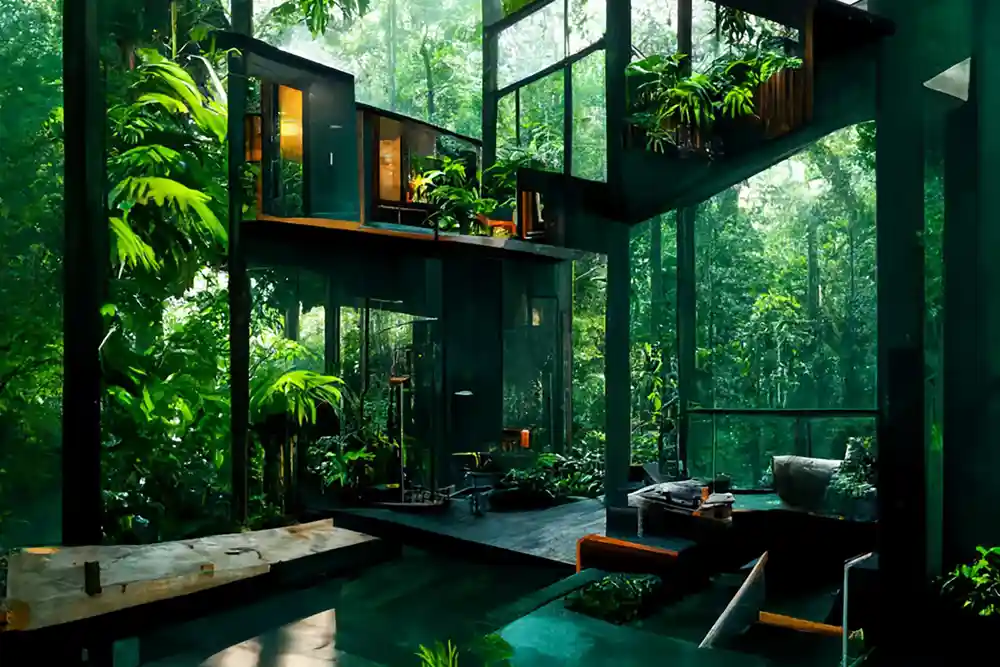Biophilic Design
A Symphony of Nature and Architecture Transforming Space
In the labyrinth of modern urban landscapes, where concrete sprawls and steel structures dominate, a growing movement seeks to reintegrate a fundamental element often overlooked—nature. Biophilic design, an innovative architectural approach, beckons us to reconnect with the natural world within the confines of our built environments. In this exploration, we delve into the profound importance of biophilic design, unraveling its intricacies, benefits, and the transformative impact it has on our surroundings.
Understanding the Essence of Biophilic Design:
At its core, biophilic design transcends the mere inclusion of greenery within architectural spaces. It embraces a holistic philosophy, acknowledging the innate human connection with nature and seeking to recreate it in the built environment. It’s a meticulous endeavor to bring the outdoors inside, mimicking nature’s patterns, textures, and rhythms to enhance our well-being, productivity, and overall quality of life.
Biophilic Elements Woven into Architecture:
Natural Light and Ventilation:
The infusion of natural light and the facilitation of fresh air circulation stand as elemental pillars of biophilic design. Strategically placed windows, skylights, and open designs not only reduce energy consumption but also foster a profound connection with the surrounding outdoors.
Green Spaces and Living Walls:
Biophilic design extends beyond traditional gardens to include living walls, rooftop oases, and carefully curated indoor plant life. These verdant elements not only purify the air but also envelop spaces with a sense of tranquility, reducing stress and enhancing the overall aesthetic appeal.
Natural Materials and Textures:
The tactility of architecture gains significance with the integration of natural materials such as wood, stone, and bamboo. Beyond their aesthetic allure, these materials evoke a tactile connection with the environment, introducing warmth, authenticity, and a timeless appeal.
Water Features:
The soothing symphony of water features, whether in the form of fountains or reflective pools, elevates the biophilic experience. The visual and auditory elements of water contribute to a serene and contemplative atmosphere, fostering a sense of calm.
Biomorphic Forms and Patterns:
Inspired by nature’s organic shapes and patterns, architects are increasingly incorporating biophilic elements into design. From furniture to overall spatial layouts, biomorphic forms create an immersive environment that resonates with the natural world.


Benefits Enfolded in Biophilic Embrace:
Enhanced Well-Being:
Numerous studies, including those by Browning, Ryan, and Clancy in “14 Patterns of Biophilic Design,” underscore the positive impact of biophilic design on mental health. Exposure to nature within built environments has been linked to reduced stress levels and an overall improvement in well-being.
Increased Productivity:
Workspaces bathed in natural light and adorned with greenery have been proven to enhance productivity and creativity. Employees in biophilic environments often report a heightened sense of well-being, leading to increased job satisfaction and engagement.
Health and Healing:
Healthcare settings are embracing biophilic design due to its positive influence on patient outcomes. The integration of nature views, natural light, and calming elements aids the healing process, contributing to faster recovery rates.
Sustainable Practices:
Biophilic design aligns seamlessly with sustainability goals. The emphasis on natural materials, energy-efficient designs, and environmentally friendly practices makes it a powerful ally in the quest for a greener, more sustainable future.
In the synthesis of nature and architecture lies the transformative power of biophilic design. It beckons us to reconsider the role of our built environment, urging architects, designers, and inhabitants alike to weave the threads of nature into the very fabric of our living spaces. As the movement gains momentum, biophilic design emerges not merely as a design trend but as a profound philosophy—an invitation to harmonize the human experience with the natural world, creating spaces that resonate with the serenity, vitality, and timelessness of the great outdoors.
Bibliography:
Browning, W. D., Ryan, C. O., & Clancy, J. O. (2014).
14 Patterns of Biophilic Design: Improving Health & Well-Being in the Built Environment. Terrapin Bright Green.
Kellert, S. R., Heerwagen, J., & Mador, M. (Eds.). (2011).
Biophilic Design: The Theory, Science and Practice of Bringing Buildings to Life. John Wiley & Sons.
Joye, Y. (2007).
Architectural lessons from environmental psychology: The case of biophilic architecture. Review of General Psychology, 11(4), 305–328.
Ulrich, R. S., Simons, R. F., Losito, B. D., Fiorito, E., Miles, M. A., & Zelson, M. (1991).
Stress recovery during exposure to natural and urban environments. Journal of Environmental Psychology, 11(3), 201–230.